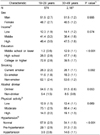1. WHO. World health report 2002: Reducing risks, promoting healthy life [Internet]. cited 2009 March 1st. Geneva: Available from:
http://www.who.int/whr/2002.
2. Sun Z, Zheng L, Wei Y, Li J, Zhang X, Liu S, Xu C, Zhao F, Hu D, Sun Y. Prevalence and risk factors of the rural adult people prehypertension status in Liaoning Province of China. Circ J. 2007. 71:550–553.

3. Ueshima H, Zhang XH, Choudhury SR. Epidemiology of hypertension in China and Japan. J Hum Hypertens. 2000. 14:765–769.

4. Korean Ministry of Health and Welfare. The Korean National Health and Nutrition Examination Survey - KNHANES I (1998). 1999. Seoul:
5. Korean Ministry of Health and Welfare. The Korean National Health and Nutrition Examination Survey - KNHANES II (2001). 2002. Seoul:
6. Korean Ministry of Health and Welfare. The Korean National Health and Nutrition Examination Survey - KNHANES III (2005). 2006. Seoul:
7. Korean Ministry of Health, Welfare, and Family Affairs & Korea Centers for Disease Control and Prevention. The Korean National Health and Nutrition Examination Survey - KNHANES IV (2007). 2008. Seoul:
8. Chobanian AV, Bakris GL, Black HR, Cushman WC, Green LA, Izzo JL Jr, Jones DW, Materson BJ, Oparil S, Wright JT Jr, Roccella EJ. Seventh report of the Joint National Committee on Prevention, Detection, Evaluation, and Treatment of High Blood Pressure. Hypertension. 2003. 42:1206–1252.

9. Droyvold WB, Midthjell K, Nilsen TI, Holmen J. Change in body mass index and its impact on blood pressure: a prospective population study. Int J Obes (Lond). 2005. 29:650–655.

10. Ruixing Y, Shangling P, Shuquan L, Dezhai Y, Weixiong L, Qiming F, Yuming C, Yaoheng H, Yijiang Z, Qinchen L. Comparison of hypertension and its risk factors between the Guangxi Bai Ku Yao and Han populations. Blood Press. 2008. 17:306–316.

11. Hermansen K. Diet, blood pressure and hypertension. Br J Nutr. 2000. 83:S113–S119.

12. Ajani UA, Dunbar SB, Ford ES, Mokdad AH, Mensah GA. Sodium intake among people with normal and high blood pressure. Am J Prev Med. 2005. 29:63–67.

13. He J, Tell GS, Tang YC, Mo PS, He GQ. Relation of electrolytes to blood pressure. Hypertension. 1991. 17:378–385.
14. Schroder H, Schmelz E, Marrugat J. Relationship between diet and blood pressure in a representative Mediterranean population. Eur J Nutr. 2002. 41:161–167.

15. Elmarsafawy SF, Jain NB, Schwartz J, Sparrow D, Nie H, Hu H. Dietary calcium as a potential modifier of the relationship of lead burden to blood pressure. Epidemiology. 2006. 17:531–537.

16. Hajjar IM, Grim CE, Kotchen TA. Dietary calcium lowers the age-related rise in blood pressure in the United States: the NHANES III survey. J Clin Hypertens (Greenwich). 2003. 5:122–126.

17. Wang L, Manson JE, Buring JE, Lee IM, Sesso HD. Dietary intake of dairy products, calcium, and vitamin D and the risk of hypertension in middle-aged and older women. Hypertension. 2008. 51:1073–1079.

18. Cohen HW, Hailpern SM, Alderman MH. Sodium intake and mortality follow-up in the Third National Health and Nutrition Examination Survey (NHANES III). J Gen Intern Med. 2008. 23:1297–1302.

19. The Korean Nutrition Society. Dietary reference intakes for Koreans. 2005. Seoul: The Korean Nutrition Society.
20. Geleijnse JM, Kok FJ, Grobbee DE. Impact of dietary and lifestyle factors on the prevalence of hypertension in Western populations. Eur J Public Health. 2004. 14:235–239.

21. Halm J, Amoako E. Physical activity recommendation for hypertension management: does healthcare provider advice make a difference? Ethn Dis. 2008. 18:278–282.
22. Onat A, Ugur M, Hergenc G, Can G, Ordu S, Dursunoglu D. Lifestyle and metabolic determinants of incident hypertension, with special reference to cigarette smoking: a longitudinal population-based study. Am J Hypertens. 2009. 22:156–162.

23. Sesso HD, Cook NR, Buring JE, Manson JE, Gaziano JM. Alcohol consumption and the risk of hypertension in women and men. Hypertension. 2008. 51:1080–1087.

24. Lin SJ, Lee KT, Lin KC, Cheng KH, Tsai WC, Sheu SH, Wu MT, Lee CH, Lai WT. Prevalence of prehypertension and associated risk factors in a rural Taiwanese adult population. Int J Cardiol. 2009. 02. 13. [Epub ahead of print].

25. Mellen PB, Gao SK, Vitolins MZ, Goff DC Jr. Deteriorating dietary habits among adults with hypertension: DASH dietary accordance, NHANES 1988-1994 and 1999-2004. Arch Intern Med. 2008. 168:308–314.

26. The DECODA Study Group. BMI compared with central obesity indicators in relation to diabetes and hypertension in Asians. Obesity (Silver Spring). 2008. 16:1622–1635.
27. Yadav S, Boddula R, Genitta G, Bhatia V, Bansal B, Kongara S, Julka S, Kumar A, Singh HK, Ramesh V, Bhatia E. Prevalence & risk factors of pre-hypertension & hypertension in an affluent north Indian population. Indian J Med Res. 2008. 128:712–720.
28. He FJ, Marrero NM, Macgregor GA. Salt and blood pressure in children and adolescents. J Hum Hypertens. 2008. 22:4–11.

29. Dickinson HO, Nicolson DJ, Campbell F, Beyer FR, Mason J. Potassium supplementation for the management of primary hypertension in adults. Cochrane Database Syst Rev. 2006. 3:CD004641.

30. Dickinson HO, Nicolson DJ, Cook JV, Campbell F, Beyer FR, Ford GA, Mason J. Calcium supplementation for the management of primary hypertension in adults. Cochrane Database Syst Rev. 2006. 2:CD004639.

31. van Mierlo LA, Arends LR, Streppel MT, Zeegers MP, Kok FJ, Grobbee DE, Geleijnse JM. Blood pressure response to calcium supplementation: a meta-analysis of randomized controlled trials. J Hum Hypertens. 2006. 20:571–580.

32. Gao SK, Fitzpatrick AL, Psaty B, Jiang R, Post W, Cutler J, Maciejewski ML. Suboptimal nutritional intake for hypertension control in 4 ethnic groups. Arch Intern Med. 2009. 169:702–707.

33. Jorde R, Sundsfjord J, Haug E, Bonaa KH. Relation between low calcium intake, parathyroid hormone, and blood pressure. Hypertension. 2000. 35:1154–1159.

34. Smajilovic S, Tfelt-Hansen J. Novel role of the calcium-sensing receptor in blood pressure modulation. Hypertension. 2008. 52:994–1000.

35. Tfelt-Hansen J, Brown EM. The calcium-sensing receptor in normal physiology and pathophysiology: a review. Crit Rev Clin Lab Sci. 2005. 42:35–70.










 PDF
PDF ePub
ePub Citation
Citation Print
Print


 XML Download
XML Download